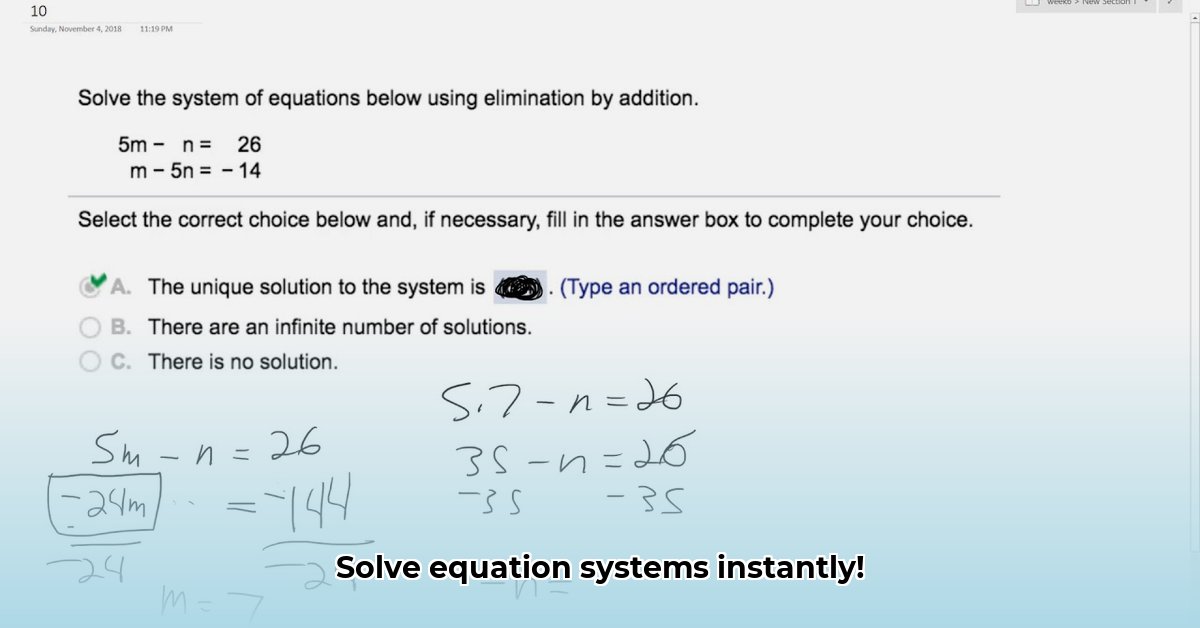
Understanding Systems of Equations and the Role of Online Solvers
Solving systems of equations is a fundamental skill in algebra, crucial for various applications in science, engineering, and economics. These systems involve finding the values of multiple variables that satisfy a set of simultaneous equations. Traditionally, methods like substitution and elimination have been used, but the advent of online equation solvers offers a powerful new tool for students and educators. These tools, such as Symbolab and Wolfram Alpha, can significantly speed up the process of solving these equations, offering immediate feedback and step-by-step solutions. However, responsible integration and understanding of their limitations are critical for maximizing their educational value. For further exploration of numerical ranges, see this helpful resource: range values.
Smart Strategies: Leveraging Online Equation Solvers Effectively
Online equation solvers are invaluable tools, but their effectiveness hinges on how they’re used. To fully utilize these resources, students and educators should adopt a strategic approach.
Independent Problem Solving First: Before resorting to a solver, attempt to solve the problem using traditional methods. This builds foundational understanding and allows for a direct comparison with the online solver's approach. This crucial step ensures genuine learning rather than mere answer-seeking.
Verification and Error Analysis: Use the online solver to verify your initial solution. If discrepancies arise, carefully analyze the steps to pinpoint errors and identify areas requiring further attention. This iterative process refines problem-solving skills.
Step-by-Step Learning: Don't just copy the final answer; pay close attention to each step of the solver's process. Understanding the mathematical rationale behind each step is key to developing deeper mathematical comprehension.
Exploration and Challenge: Utilize the solver to tackle more complex problems that would be challenging to solve manually. This fosters a sense of accomplishment and expands mathematical horizons.
The Two Sides of the Coin: Benefits and Drawbacks of Online Solvers
Like any educational technology, online equation solvers offer both advantages and disadvantages:
Advantages:
- Increased Efficiency: Solvers significantly reduce the time required to solve complex problems, allowing students to work through more examples and practice.
- Detailed Solutions: Step-by-step explanations provide clear insights into the solution process, clarifying potentially confusing concepts.
- Accessibility to Challenging Problems: Solvers enable exploration of sophisticated problems that would otherwise be inaccessible to many students.
- Personalized Learning: Many solvers offer a range of solution methods, catering to various learning styles and preferences.
Disadvantages:
- Over-Reliance: The convenience of solvers can lead to over-dependence, hindering the development of independent problem-solving skills. "It is crucial to prevent students from becoming overly reliant on these tools," says Dr. Anya Petrova, Professor of Mathematics Education at the University of California, Berkeley.
- Superficial Understanding: Simply copying solutions without understanding the underlying concepts prevents true mathematical learning. This ultimately limits comprehension and application of the material.
- Potential for Inaccuracies: While generally reliable, solvers are not infallible. Critical thinking is necessary to evaluate the reasonableness of provided solutions.
- Equity Concerns: Unequal access to technology and reliable internet creates disparities in educational opportunities.
Integrating Online Solvers into High School Math Curricula: A Balanced Approach
Effective integration of online equation solvers requires careful planning and implementation. Here’s a practical framework:
- Gradual Introduction: Introduce solvers gradually, starting with simple problems to build confidence. Explain their purposes and limitations explicitly.
- Supplement, Not Replace: Solvers should supplement, not substitute, traditional methods. Emphasize the importance of understanding fundamental concepts.
- Focus on Conceptual Understanding: After using a solver, facilitate discussions on the solution process, exploring alternative methods and relating the work to learned theory.
- Assessment Design: Design assessments that measure true comprehension, not just the ability to obtain correct answers using technology.
- Address Ethical Considerations: Discuss potential biases in algorithms and the importance of critical evaluation of solver outputs.
Mitigating Potential Risks
A proactive approach is needed to address potential pitfalls:
| Risk | Mitigation Strategy |
|---|---|
| Over-reliance | Emphasize independent problem-solving; use solvers for verification only. |
| Superficial Understanding | Focus on explanation of solution steps and underlying principles. |
| Algorithmic Bias | Promote awareness of potential bias; encourage critical evaluation of results. |
Conclusion: Empowering Students Through Strategic Technology Integration
Online equation solvers are powerful tools that can significantly enhance mathematics education. By integrating them thoughtfully and strategically, educators can empower students to achieve a deeper understanding of systems of equations while fostering essential problem-solving and critical-thinking skills. The key lies in utilizing these tools judiciously, balancing technological support with robust foundational learning. The result is a more efficient and effective learning process for all.